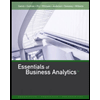
a.
Adequate information:
| Year | Cash Flows |
| 0 | $8,700 |
| 1 | -$3,900 |
| 2 | -$2,900 |
| 3 | -$2,300 |
| 4 | -$1,800 |
To compute: The
Introduction: Internal rate of return (IRR) is defined as the discount rate at which the aggregate present value of net
b.
Adequate information:
| Year | Cash Flows |
| 0 | $8,700 |
| 1 | -$3,900 |
| 2 | -$2,900 |
| 3 | -$2,300 |
| 4 | -$1,800 |
Appropriate discount rate = 10%
To determine: Whether the offer should be accepted if the appropriate discount rate is 10%.
Introduction: Internal rate of return refers to the discount rate at which the
c.
Adequate information:
| Year | Cash Flows |
| 0 | $8,700 |
| 1 | -$3,900 |
| 2 | -$2,900 |
| 3 | -$2,300 |
| 4 | -$1,800 |
Appropriate discount rate = 20%
To compute: Whether the offer should be accepted if the appropriate discount rate is 20%.
Introduction: Internal rate of return refers to the discount rate at which the net present value of the project is zero.
d.
Adequate information:
| Year | Cash Flows |
| 0 | $8,700 |
| 1 | -$3,900 |
| 2 | -$2,900 |
| 3 | -$2,300 |
| 4 | -$1,800 |
To compute:
- The net present value (NPV) of the offer if the appropriate discount rate is 10%.
- The net present value (NPV) of the offer if the appropriate discount rate is 20%.
Introduction: Net present value is defined as the summation of the present value of cash inflows in each period minus the summation of the present value of
e.
Adequate information:
| Year | Cash Flows |
| 0 | $8,700 |
| 1 | -$3,900 |
| 2 | -$2,900 |
| 3 | -$2,300 |
| 4 | -$1,800 |
To explain: Whether the decisions under the NPV rule are consistent with those of the IRR rule.
Introduction:
The Internal Rate of Return (IRR) is the discount rate that will equate the present value of the cash inflows to the present value of the cash outflows.
The Net Present Value (NPV) is the difference between the present value of cash inflows and the present value of cash outflows of a proposal.
Want to see the full answer?
Check out a sample textbook solution
Chapter 5 Solutions
Loose Leaf for Corporate Finance Format: Loose-leaf
- Black Oil Company is trying to decide whether to lease or buy a new computer-assisted drilling system for its extraction business. Management has already determined that acquisition of the system has a positive NPV. The system costs $9.4 million and qualifies for a 25% CCA rate. The equipment will have a $975,000 salvage value in five years. Black Oil’s tax rate is 36%, and the firm can borrow at 9%. Cape Town Company has offered to lease the drilling equipment to Black Oil for payments of $2.15 million per year. Cape Town’s policy is to require its lessees to make payments at the start of the year. Suppose it is estimated that the equipment will have no savage value at the end of the lease. What is the maximum lease payment acceptable to Black Oil now?arrow_forwardSpace Exploration Technology Corporation (Space X), is an aerospace manufacturer that sells stock engine components and tests equipment for commercial space transportation. A new customer has placed an order for eight high-bypass turbine engines, which increase fuel economy. The variable cost is $1.6 million per unit, and the credit price is $1.725 million each. Credit is extended for one period, and based on historical experience, payment for about one out of every 200 such orders is never collected. The required return is 1.8% per period. Required Assuming that this is a one-time order, should it be filled? The customer will not buy if credit is not extended. What is the break-even probability of default in part 1? Suppose that customers who don’t default become repeat customers and place the same order every period forever. Further assume that repeat customers never default. Should the order be filled? What is the break-even probability of default?arrow_forwardSouth African Airlines is contemplating leasing a high-tech tracker for its fleet of airplanes. Leasing is a very common practice with expensive, high-tech equipment. The scanner costs $6.3 million and it qualifies for a 30% CCA rate. Because of the rapid progression of technology, the high-tech tracker will be valued at $0 in 4 years. You can lease it for $1.875 million per year for four years. Assume that assets pool remains open and payments are made at the end of the year. Assuming a tax rate of 37%. You can borrow at 8% pre-tax. Should you lease or buy?arrow_forward
- Black Oil Company is trying to decide whether to lease or buy a new computer-assisted drilling system for its extraction business. Management has already determined that acquisition of the system has a positive NPV. The system costs $9.4 million and qualifies for a 25% CCA rate. The equipment will have a $975,000 salvage value in five years. Black Oil’s tax rate is 36%, and the firm can borrow at 9%. Cape Town Company has offered to lease the drilling equipment to Black Oil for payments of $2.15 million per year. Cape Town’s policy is to require its lessees to make payments at the start of the year. What is the NAL for Black Oil Company? What is the maximum lease payment that would be acceptable to the company?arrow_forwardIceberg Corporation currently has an all-equity capital structure. The company is considering a new structure that holds 30% debt. There are 6,500 shares outstanding and the price per share is $45 today. EBIT is expected to remain at $29,000 per year forever. The interest rate on new debt is 8%, and there are no taxes. Required Justin, a shareholder of the firm, owns 100 shares of stock. What is his cash flow under the current capital structure, assuming the company has a dividend payout rate of 100%? What will Justin’s cash flow be under the proposed capital structure of the firm? Assume he keeps all 100 of his shares. Suppose the company does convert, but Justin prefers the current all-equity capital structure. Show how he could unlever his shares of stock to recreate the original capital structure.arrow_forwardCovehead Lighthouse Corporation is considering a change in its cash-only policy. The new terms would be net one period. Based on the following information, determine if Covehead Lighthouse should proceed or not. The required rate of return is 2.5% per period. Current Policy New Policy Price per unit $73 $75 Cost per unit $38 $38 Unit sales per month 3,280 3,390arrow_forward
- The YYY and ZZZ Company are two firms whose business risk are the same but that have different dividend policies. YYY pays no dividend, whereas ZZZ has an expected dividend yield of 4%. Suppose the capital gains tax rate is zero, whereas the income tax rate is 35%. YYY has an expected earnings growth rate of 15% annually, and its stock price is expected to grow at this same rate. If the after-tax expected returns on the two stocks are equal, what is the pre-tax required return on ZZZ stock?arrow_forwardCharlie Corporation is analyzing the possible acquisition of Delta Inc. Neither firm has debt. The forecasts of Charlie show that the purchase would increase its annual after-tax cash flow by $425,000 indefinitely. The current market value of Delta is $8.8 million. The current market value of Charlie is $22 million. The appropriate discount rate for the incremental cash flows is 8%. Charlie is trying to decide whether it should offer 35% of its stock or $12 million in cash to Delta. Required What is the synergy from the merger? What is the value of Delta to Charlie? What is the cost to Charlie of each alternative? What is the NPV of Charlie of each alternative?arrow_forwardParadox Corporation is evaluating an extra dividend verses a share repurchase. In either case, $14,500 would be spent. Current earnings are $1.65 per share, and the stock currently sells for $58 per share. There are 2,000 shares outstanding. Ignore taxes and other imperfections in answering the following questions: Required Evaluate the two alternatives in terms of the effect on the price per share of the stock and shareholder wealth. What will be the effect on Paradox Corporation’s EPS and P/E ratio under the two different scenarios? In the real world, which of these actions would you recommend? Why?arrow_forward
- The statement of financial position, from a market value, is shown below for AAA Corporation. AAA has declared a 25% stock dividend. The stock goes ex dividend tomorrow. There are currently 13,000 shares of stock outstanding. What will the ex-dividend price be? Market Value Statement of Financial Position Cash $83,000 Debt $121,000 Fixed Assets 575,000 Equity 537,000 Total $658,000 Total $658,000arrow_forwardOne Potato Two Potato Corporation sells potato chips internationally from PEI. Its credit terms are 2/10 net 30. Based on experience, 65% of all customers will take the discount. Required What is the average collection period for One Potato Two Potato? If One Potato Two Potato sells 1,300 ‘orders’ every month at a price of $1,750 each, what is its average balance sheet amount in accounts receivable? Assume 365 days per year.arrow_forwardPinnacle Corporation expects an EBIT of $19,750 every year in perpetuity. Currently the company has no debt on their books and its cost of equity is 15%. Pinnacle can borrow at a rate of 10%. If the corporate tax rate is 35%, what is the value of the firm? What will the value be if the company converts to 50% debt? To 100% debt?arrow_forward
 Essentials of Business Analytics (MindTap Course ...StatisticsISBN:9781305627734Author:Jeffrey D. Camm, James J. Cochran, Michael J. Fry, Jeffrey W. Ohlmann, David R. AndersonPublisher:Cengage Learning
Essentials of Business Analytics (MindTap Course ...StatisticsISBN:9781305627734Author:Jeffrey D. Camm, James J. Cochran, Michael J. Fry, Jeffrey W. Ohlmann, David R. AndersonPublisher:Cengage Learning
